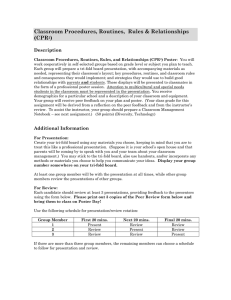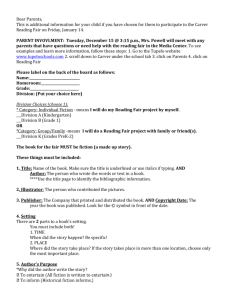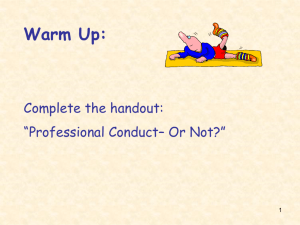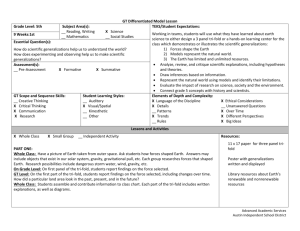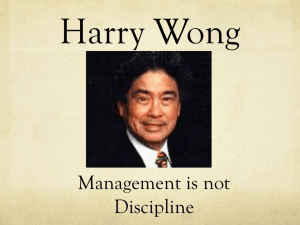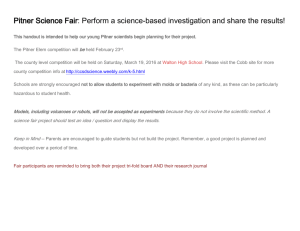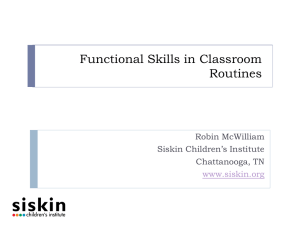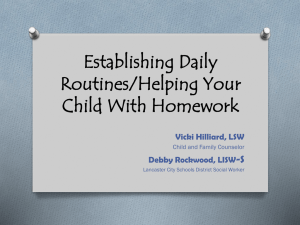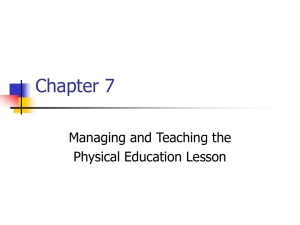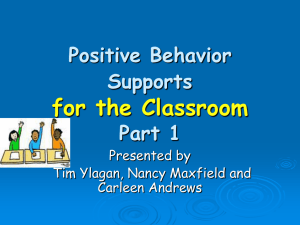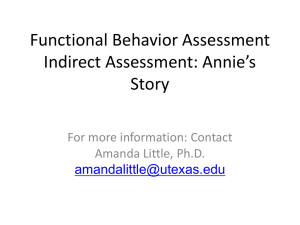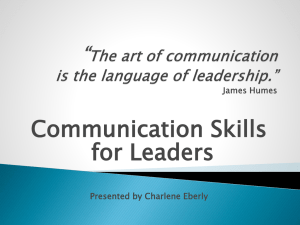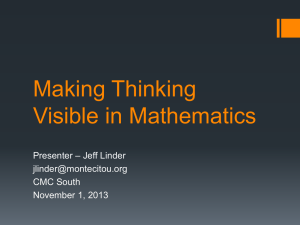Classroom Management - Baltimore County Public Schools
advertisement
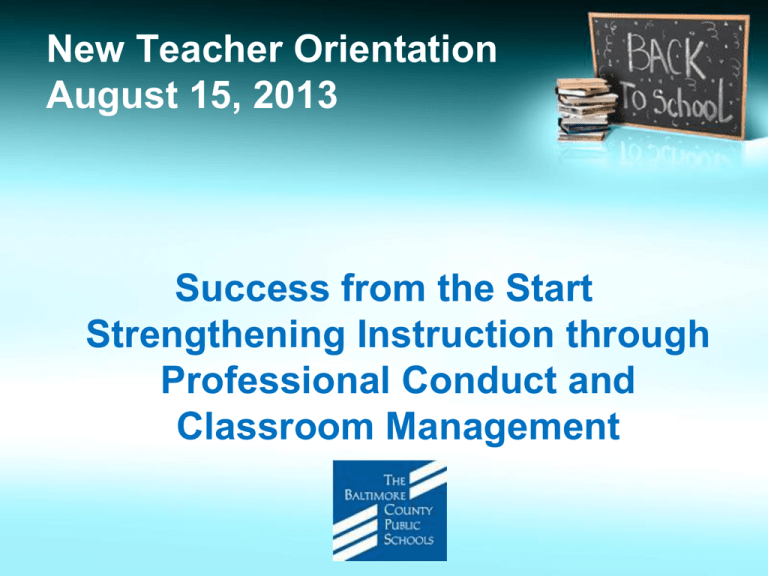
New Teacher Orientation August 15, 2013 Success from the Start Strengthening Instruction through Professional Conduct and Classroom Management Warm Up: Complete the handout: “Professional Conduct – Or Not?” Maryland Teacher Professional Development Standards Content Standards V. Student Learning Environments – Effective professional development ensures that all teachers are able to create safe, secure, and supportive learning environments for all students. Indicator 5b. Professional development provides opportunities for teachers to develop and practice student ownership of management routines and practice creative solutions to conflicts. Today’s Objective Participants will examine various strategies to manage one’s self and one’s classroom in order to develop a plan that establishes a safe and orderly learning environment. Take - Away • Create a tri-fold. • Title the cover “My Management Plan.” • Title the first section “Managing My Self.” • Title the second section “Managing My Classroom.” • Title the third section “Building Relationships with Students.” Video Clip • Watch the video clip from Bad Teacher. • Be prepared to discuss the teacher’s professional conduct. Maintaining Professional Conduct Review BCPS Board Policy and Rule 4100. Contact your principal with any questions. Managing One’s Self • Define Your Role – You are a Teacher. – You are NOT the parent. – You are NOT a peer. Set Boundaries • Respect and maintain appropriate boundaries. • Engage in appropriate conversations. • Compliment and provide rewards and consequences appropriately. Become a Positive Role Model • Dress professionally. • Speak and write professionally utilizing correct grammar. • Be respectful and responsible. • Maintain student confidentiality. • Manage your on-line footprint. • Plan for success. Take – Away Reflect on Board Policy and Rule 4100. On the “Managing My Self” section of your tri-fold: • identify an ‘a-ha’ • predict how it will affect your classroom management. Today’s Objective Participants will examine various strategies to manage one’s self and one’s classroom in order to develop a plan that establishes a safe and orderly learning environment. Managing the Classroom What are the differences between a procedure/routine and a rule? • A procedure is a method of how activities are to be done in the classroom/school. • A rule sets limits to guide behavior and provides consequences, positive or negative. Carousel– Establishing and Maintaining Routines • Chart paper is posted around the room with five routines that are important to establish and maintain in your classroom. • Stand in front of your designated poster with your assigned group. • When the instructor tells you to begin, discuss the routine with your group and write how you could establish this routine in your classroom. • After 1 minute, you will move with your group to the next poster to discuss and write about the next routine. Take – Away • Gallery Walk - Take a walk around the room to review the responses. • On the “Managing My Classroom” section of your tri-fold, add two or more routines/procedures that you will establish in your classroom. Teaching Procedures Explain. State, explain, model, and demonstrate the procedure. Rehearse. Rehearse and practice the procedure. Reinforce. Reteach, rehearse, practice, and reinforce the procedure until it becomes a student habit or routine. Procedures and Room Arrangement • An important component in successful classroom management is arranging the physical setting for teaching to support the procedures you have in your classroom. • Effective room arrangement can help you cope with the complex demands of teaching 20 to 30 students in your classroom. Five Keys to Effective Room Arrangement • Design your classroom to reflect your personality and instructional style and needs of the students. • Keep high traffic areas free of congestion. • Arrange students where they can be easily seen by the teacher. • Place frequently used teaching materials and student supplies where they are readily accessible. • Place displays and instructional materials where they can be easily seen by the students. Room Arrangement The most important feature of room arrangement is not where the furniture goes, but, rather, where it does not go. (Jones, 2000) Additional Room Arrangements That Work! Take - Away On the back of your tri-fold, describe or draw your first seating arrangement for your classroom. Be sure to include the placement of your desk and at least one area designated for student supplies/materials or books. “Say what you mean, and mean what you say.” Fred Jones Common Misconceptions Concerning Classroom Rules (Jones, 1996) • Students should know how to behave by this time. • Rules are announced. • If you do a good job with your rules at the beginning of the year, you will not have to deal with them later. • Teaching rules is a matter of being strict. • Students dislike classroom rules. • I have so much material to cover, I can’t afford two weeks for rules. Important Considerations Rules should: • • • • Be specific, to the point, and consistent with established school rules. Be written, using positive language. Be limited to 3 - 5 in number. Be posted with the consequences. Take-Away As you review the important considerations about rules, add two rules to the “Managing My Classroom” section of your tri-fold that you will implement in your classroom. Building Relationships “The quality of teacher-student relationships is the keystone for all other aspects of classroom management.” (Marzano and Marzano, Dimensions of Learning) Suggestions for Building Relationships • Address students by name. • Demonstrate civility (Say, “Please,” “Thank you,” “I’m sorry.”). • Know your students as individuals. • Be approachable and capable but don’t be a pal. • Reveal passion for your work and for life. • Smile! Activities for Building Relationships • • • • • Introduce Yourself “All About Me” Bags Team Building Activities Personal Interest Inventories Others ???? Take – Away On the “Building Relationships with Students” section of your tri-fold, add two ways you will create relationships with the students in your classroom. Today’s Objective Participants will examine various strategies to manage one’s self and one’s classroom in order to develop a plan that establishes a safe and orderly learning environment. Summary • Clearly define your role as a teacher and set boundaries. • Clearly define and teach classroom procedures, routines, and rules. • Model respect. Build positive relationships. • Monitor student behaviors and address inappropriate behavior promptly and consistently. • Plan effective lessons every day. “What you do on the first days of school will determine your success or failure for the rest of the school year. You will either win or lose your class on the first days of school.” -Harry Wong PowerPoint • To access a copy of the PowerPoint presentation for this workshop, as well as many other useful resources for BCPS new teachers, go to the New Teacher Resource Portal. • A link to the New Teacher Resource Portal is included on the flash drive you received in your tote bag. Resources • Bad Teacher. Dir. Jake Kasdan. Perf. Cameron Diaz, Jason Segel, and Justin Timberlake. 2011. DVD. Columbia Pictures. • Baltimore County Board of Education. Policy and Rule 4100. • Howard, Lynn F. Ready for Anything - Supporting New Teachers for Success. Englewood, CO: Advanced Learning Press, 2006. • Jones, Fredric H. Positive Classroom Discipline. New York: McGraw-Hill, 1987. • McCarney, Stephen B., Kathy Cummins Wunderlich, and Angela M. Bauer. Pre-Referral and Intervention Manual. Columbia, MO: Hawthorne Educational Resources, 1999. Resources • Orange, Carolyn. 44 Smart Strategies for Avoiding Classroom Mistakes. Thousand Oaks, CA: A Sage Publications, CO, 2005. • Paterson, Kathy. 55 Teaching Dilemmas. Ontario, Canada: Pembroke Publishers, 2005. • Rutherford, Paula, Why Didn’t I Learn This in College?. Alexandria, VA: Just Ask Publications, 2002. • Staff of Canter & Associates, eds. First-Class Teacher: Success Strategies for New Teachers. Santa Monica, CA: Canter and Associates, Inc., 1998. • Wong, Harry K. and Rosemary T. Wong. The First Days of School. Mountain View, CA: Harry K. Wong Publications, Inc., 2005.
